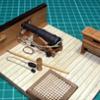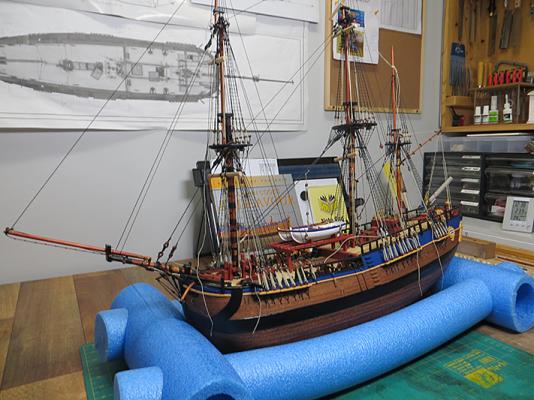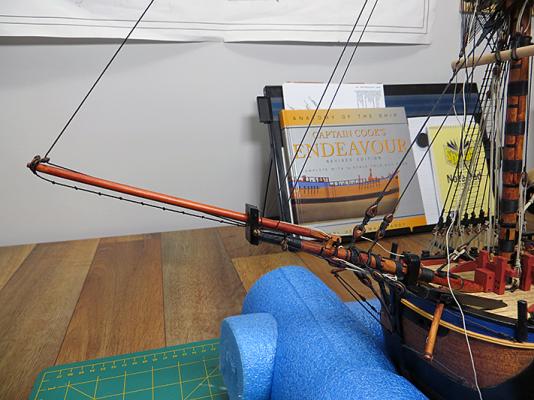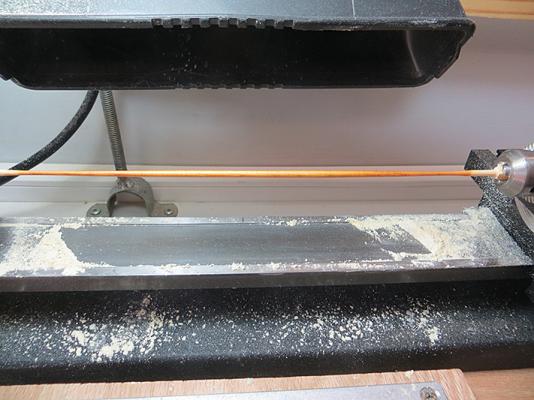-
Posts
5,946 -
Joined
-
Last visited
Content Type
Profiles
Forums
Gallery
Events
Everything posted by BANYAN
-

What is the name for the netting under the bowsprit
BANYAN replied to HKC's topic in Masting, rigging and sails
Thanks Steve and JB. Steve that photo is perfect - many thanks for that - much appreciate the rapid response. I was a bit puzzled by marquardt's depiction as i could not see a 'seaman' like way to utilise a central line either end; the spreaders make much more practical sense. cheers Pat -
Thanks Dave, that's the plan re Endeavour (and a couple of frosties of course ) cheers Pat
- 517 replies
-
- Endeavour
- Artesania Latina
-
(and 1 more)
Tagged with:
-

What is the name for the netting under the bowsprit
BANYAN replied to HKC's topic in Masting, rigging and sails
HKC - I hope you don't mind me high jacking your thread after such a long period of inactivity? In the Endeavour AOTS, this netting is referenced as being for the staysail ( to hold the 'bundle' when lowered). My question is how it was rigged circa 1770. the AOTS shows only a side view. In this view there is a 'horse' which I am presuming is one each side. I initially assumed the netting was fixed between these but there also appears to be a small eye ring centrally placed at either end fixed to the boom collar (fwd side) and boom cap (aft side) to which the net was attached. Would I be right in assuming that it was fitted between the horses (hitched) to act as spreaders and the central eye rings to give fore and aft support to the net? OR was it hung more like a hammock? Any pointers/suggestions appreciated as there is nothing in Lees, Lever, Marquardt, Harland or Falconer (that I can find) to provide this detail. cheers Pat -
Thanks all for looking in. ca shipwright - More ships??? Flat out keeping up with what I have in the shipyard Good to see you back in the dockyard Mike. Greg, Popeye - unfortunately retiring 5 years earlier than planned for health reasons - get some quality of life in while I can. My complaints however are minor compared to many! cheers Pat
- 517 replies
-
- Endeavour
- Artesania Latina
-
(and 1 more)
Tagged with:
-
Thanks Mark and back at you - I hope you and yours had a great festive season With the Death Star commissioned I am sure 2016 will be a great modelling year. cheers Pat
- 517 replies
-
- Endeavour
- Artesania Latina
-
(and 1 more)
Tagged with:
-
You too mate - 2016 will have to be better - now retired cheers Pat
- 517 replies
-
- Endeavour
- Artesania Latina
-
(and 1 more)
Tagged with:
-
So what was this about blemish lines - can't see them standing up this way Looks great Mark! cheers Pat
-
Thanks Popeye, ditto. I also hope you and your family had a great festive season and have much to look forward to in 2016. cheers Pat
- 517 replies
-
- Endeavour
- Artesania Latina
-
(and 1 more)
Tagged with:
-
Great progress Greg - looking very good indeed. At this pace you'll be finished by NYD cheers Pat
-
Coming along rapidly and looking great Danny; must be a bit of a doddle after the full shiop model? cheers Pat
- 268 replies
-
Thanks again to all those whom have looked in and "liked' - appreciate you dropping by. Hi Per great to see you drop in; thanks for your very positive comments. The AOTS has been very helpful with this build. It's going to be a very hot summer this year; lucky for us a cooler Christmas as we have some major bushfires just down the road from us on the "Great Ocean Road" with some 120 properties/homes lost already; the cooler weather had allowed the firefighters a little respite to try and control it. Warming up again later this week - we have already had a couple of days in the 4o+ Cel. range - good excuse for a couple of 'frosties' (beers) cheers Pat
- 517 replies
-
- Endeavour
- Artesania Latina
-
(and 1 more)
Tagged with:
-
Nice work on the stern Mark; ditto John's remarks. We tend to be harder on ourselves than others and mostly the small issues you identify are only visible under harsh (bright) light and close-up photography - the real thing was probably a lot rougher to the eye than you have produced. cheers Pat
-
Thanks for looking in folks and the comments Mark and John - appreciate the interest and encouragement. cheers Pat
- 517 replies
-
- Endeavour
- Artesania Latina
-
(and 1 more)
Tagged with:
-
Well the 'knitting' is now done with all ratlines finished That is milestone completed and another started with a good start made on the jib and spritsail yards. cheers Pat
- 517 replies
-
- Endeavour
- Artesania Latina
-
(and 1 more)
Tagged with:
-
Those guns look great Greg - looka like you are just having too much fun with plastic- any chance of a return to the dark side? cheers Pat
-
Great update John; she is coming along very nicely. Our best wishes to you and your lovely wife for a happy and safe festive season and a great modelling 2016. cheers Pat
- 745 replies
-
- francis pritt
- mission ship
-
(and 1 more)
Tagged with:
-
Looks ghreat as ir is Mark. This gives you the excuse to have a really good festive season celebration - well two excuses cheers Pat
-
Okay - I'll jump inm also - Happy birthday. Love this log simply for learning the ways you approach each detail. keep them coming (after appropriate birthday celebrations of course ) cheers Pat
- 1,215 replies
-
- sloop
- kingfisher
-
(and 1 more)
Tagged with:
-
A major milestone desreves a major celebration - just don't use any powertools until the hangover is gone Well done mate, looks good. cheers Pat
-
Hi Greg, another nice build you have going here. I am almost finished my Endeavour, so will get onto my Vampire (1:350) soon - be watching this log for hints and tips for plastic models So, I assume the Sydney next in a nice little diorama? cheers Pat
-

Bolt Heads on Brass Strips
BANYAN replied to mikiek's topic in Metal Work, Soldering and Metal Fittings
Mikie, you might also investigate using a punch and die set such as the one shown here: https://www.youtube.com/watch?v=5m4qaRcmXdU There are several different versions from different companies; some use plastic card, others user a shim metal to create the shapes. These are very realistic finishes but the punch/die sets can be a tad expensive - so you will need to evaluate how often you would use it. cheers Pat
About us
Modelshipworld - Advancing Ship Modeling through Research
SSL Secured
Your security is important for us so this Website is SSL-Secured
NRG Mailing Address
Nautical Research Guild
237 South Lincoln Street
Westmont IL, 60559-1917
Model Ship World ® and the MSW logo are Registered Trademarks, and belong to the Nautical Research Guild (United States Patent and Trademark Office: No. 6,929,264 & No. 6,929,274, registered Dec. 20, 2022)
Helpful Links
About the NRG
If you enjoy building ship models that are historically accurate as well as beautiful, then The Nautical Research Guild (NRG) is just right for you.
The Guild is a non-profit educational organization whose mission is to “Advance Ship Modeling Through Research”. We provide support to our members in their efforts to raise the quality of their model ships.
The Nautical Research Guild has published our world-renowned quarterly magazine, The Nautical Research Journal, since 1955. The pages of the Journal are full of articles by accomplished ship modelers who show you how they create those exquisite details on their models, and by maritime historians who show you the correct details to build. The Journal is available in both print and digital editions. Go to the NRG web site (www.thenrg.org) to download a complimentary digital copy of the Journal. The NRG also publishes plan sets, books and compilations of back issues of the Journal and the former Ships in Scale and Model Ship Builder magazines.





